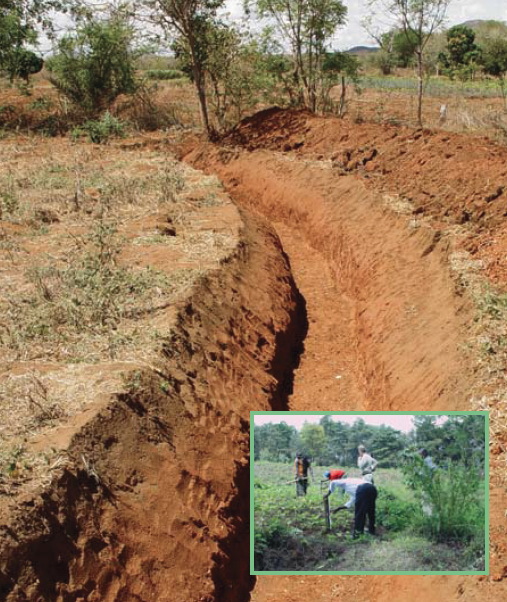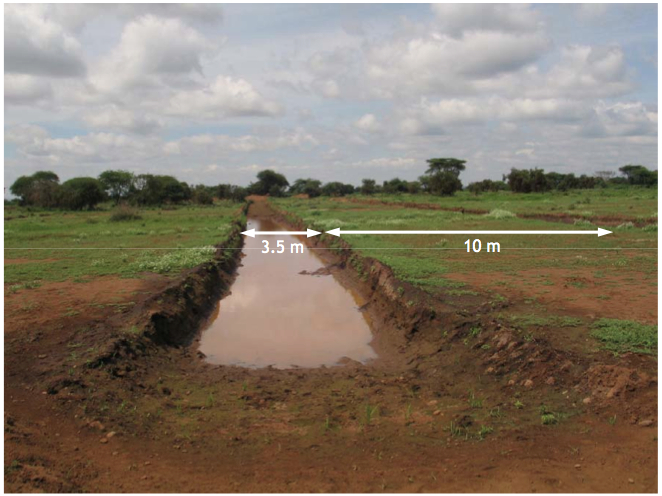Difference between revisions of "Water Portal / Rainwater Harvesting / Groundwater recharge / Contour trenches"
| Line 1: | Line 1: | ||
__NOTOC__ | __NOTOC__ | ||
[[Image:contour trch icon.png|right]] | [[Image:contour trch icon.png|right]] | ||
| − | [[Image:contour_trench.JPG|thumb|right| | + | [[Image:contour_trench.JPG|thumb|right|200px| Contour trench under construction and measuring contours with hose pipes. Photo: WTC.]] |
At its simplest, contour trench construction is an extension of the practice of plowing fields at a right angle to the slope. Contour trenches are ditches dug along a hillside in such a way that they follow a contour and run perpendicular to the flow of water. The soil excavated from the ditch is used to form a berm (a narrow shelf) on the downhill edge of the ditch. The berm can be planted with permanent vegetation (native grasses, legumes) to stabilize the soil and for the roots and foliage in order to trap any sediment that would overflow from the trench in heavy rainfall events. | At its simplest, contour trench construction is an extension of the practice of plowing fields at a right angle to the slope. Contour trenches are ditches dug along a hillside in such a way that they follow a contour and run perpendicular to the flow of water. The soil excavated from the ditch is used to form a berm (a narrow shelf) on the downhill edge of the ditch. The berm can be planted with permanent vegetation (native grasses, legumes) to stabilize the soil and for the roots and foliage in order to trap any sediment that would overflow from the trench in heavy rainfall events. | ||
| Line 45: | Line 45: | ||
==Construction, operations and maintenance== | ==Construction, operations and maintenance== | ||
| − | [[Image:Contour_Trench.JPG|thumb|right| | + | [[Image:Contour_Trench.JPG|thumb|right|200px|An example of contour trench in Kitenden, Vietnam. <br> Source: Westerveld Conservation Trust]] |
In order to efficiently capture runoff in a catchment through appropriately sized trenches, the following information and analysis is needed: | In order to efficiently capture runoff in a catchment through appropriately sized trenches, the following information and analysis is needed: | ||
* Catchment area, gathered from topographical maps | * Catchment area, gathered from topographical maps | ||
Revision as of 00:00, 24 September 2013
At its simplest, contour trench construction is an extension of the practice of plowing fields at a right angle to the slope. Contour trenches are ditches dug along a hillside in such a way that they follow a contour and run perpendicular to the flow of water. The soil excavated from the ditch is used to form a berm (a narrow shelf) on the downhill edge of the ditch. The berm can be planted with permanent vegetation (native grasses, legumes) to stabilize the soil and for the roots and foliage in order to trap any sediment that would overflow from the trench in heavy rainfall events.
Contour trenches are not irrigation channels, rather they are used to slow down and attract runoff water, which then infiltrates into the soil. Small scale contour trenches can also be used within field level. The water that infiltrates can be used as soil moisture for crops cultivated after a rainfall event, directly for pumped irrigation, or extracted from shallow wells in the area.
Suitable conditions
- Locate trenches in natural runoff areas, but not on slopes over 10%.
- Soil in vicinity needs to have sufficient infiltration capacity and potential sub-surface storage capacity.
- In areas which have very heavy storms it may be dangerous to prevent the water completely from flowing down a slope. Build waterways or drains at a slight angle (1⁄2 degree - 1 degree) so that excess water is safely channeled away.
| Advantages | Disadvantages |
|---|---|
| - Facilitates recharge into surrounding ground which in turn improves soil moisture - Improves agricultural productivity and grazing potential as well as increases water for livestock and therefore mitigates against drought |
- Recharge of groundwater is not certain according to local sub-surface conditions (geological layers blocking infiltration) - Trenches silt up and will need maintenance |
Resilience to changes in the environment
Drought
Effects of drought: Lower crop yields.
Underlying causes of effects: Water levels reduce; Less recharge to aquifers & crops.
To increase resiliency of WASH system: Diversify livelihoods of farmers.
More information on managing drought: Resilient WASH systems in drought-prone areas.
Floods
Contour trenches specifically help control flooding and capture water from floods. If rain event is expected to be massive, plant vegetation along the outer edge of the contour to stabilise the trenches and prevent erosion.
Construction, operations and maintenance
In order to efficiently capture runoff in a catchment through appropriately sized trenches, the following information and analysis is needed:
- Catchment area, gathered from topographical maps
- Detailed rainfall data (which is used to create a rainfall frequency analysis where precipitation level and probable recurrence interval). Using this data, the predicted runoff for a particular intensity of rainfall can be shown using the Soil Conservation Service (SCS) method, which is a simple way to calculate runoff in ungauged catchments. To calculate runoff, the following is needed: precipitation for a particular rainfall recurrence interval (e.g. 5 years), catchment area, soil characteristics, and land use in catchment. For a given recurrence interval, the total amount of runoff for the catchment can then be calculated.
- Soil infiltration rates and soil properties based on physical soil investigations on site (e.g. how does sandy, loamy, or clay soils absorb water?)
- Once area, rainfall data, and soil data are collected, then total trench capacity can be determined. The runoff volume minus what would infiltrate in the trenches during the rainfall event would be the trench capacity.
- Trench dimension and spacing in the catchment can now be calculated. This has to be checked with local preferences and adjusted accordingly. Trenches in Vietnam were originally designed as rectangular trenches 4m wide by 1m deep, but modified according to requests from local people to trapezoidal trenches 2.5m wide at top and 1m wide at base and 0.75m deep. Trenches should also be over-dimensioned (exaggerated) to allow long-term runoff volume to be stored despite a lack of maintenance – things like siltation and erosion of the banks will reduce infiltration capacity and volume over time.
- It seems wise to pilot contour trenches in an area before scaling up.
Digging the trenches
- Trenches are dug in line with topographical contours. Ploughing is not recommended as it induces evaporation.
- Constructing trenches primarily to favour plant growth and increase agricultural productivity (as was the case in Vietnam) rather than just as a means to increase groundwater levels, seems to be a good approach because there can be increased interest to ensure operation & maintenance of the trenches (in Vietnam, people wanted to establish a group of landowners to take care of the structures in order to ensure continued crop yields. The knock-on effects on shallow groundwater levels are thereby made sustainable since the primary concern for people was an economic one.)
- Excavated soil can be used to fill up existing gullies.
- Trenches can be connected to the wall of a sand dam, increasing filtration.
- Involvement of local people in the design of the project ensures that their participation continues.
Costs
- In Vietnam, after trenches were completed farmers were discussing ways to access low-cost loans with long-time repayment
conditions so that they could replicate the technology. Access to finance therefore seems to be important in scaling up this technology.
- Cost of excavation in Vietnam was around 1,000 Euro per hectare.
- Materials: US$2.6/m3 or US$4,100/ha.
- Labour: 1.5m3 per person per day manual earth movement.
Field experiences
Experience from Vietnam showed that in 5 out of 7 shallow wells that were near the trenches with water tables of between 3 and 18 metres below ground level, showed an increase in water levels after rainfall events of over 60mm because of infiltration from the contour trenches. It seems that recharge of groundwater is not certain according to local sub-surface conditions – in Vietnam, water levels in 2 out of the 7 wells near the trenches were unaffected. This is probably due to certain geological layers blocking infiltration. So it is always a possibility that trenches will not affect water levels.
Successful Water Conservation in Awalkhed Village, Nasik.
Manuals, videos, and links
- Manual: The Design of Contour Trenches in Vietnam Copyright by Kharis Erasta Reza Pramana Delft, The Netherlands, October 2007.
- Manual: Design Manual: Contour Trenches - Using the "A" frame and how to make a contour trench.
Acknowledgements
- CARE Nederland, Desk Study: Resilient WASH systems in drought-prone areas. October 2010.
- Sussman, Daniel. Design Manual: Contour Trenches. Bren School of Environmental Science and Management, University of California Santa Barbara. 2007.
- Smart Water Harvesting Solutions: Examples of innovative, low cost technologies for rain, fog, and runoff water and groundwater. (or alternative link) Netherlands Water Partnership, Aqua for All, Agromisa, et al. 2007.


